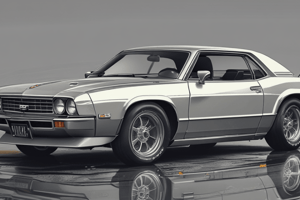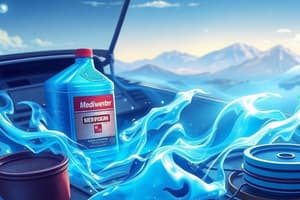Podcast
Questions and Answers
When should the car's coolant level be checked?
When should the car's coolant level be checked?
- When the car is accelerating
- When the car is hot
- When the car is stopped
- When the car is cold (correct)
What is the purpose of purging the cooling system?
What is the purpose of purging the cooling system?
- To remove air pockets and ensure proper functioning (correct)
- To check the coolant level when the car is hot
- To increase the coolant flow
- To adjust the coolant level to the recommended level
Why should the radiator cap be handled carefully?
Why should the radiator cap be handled carefully?
- It can spill coolant if not removed correctly
- It can break if over-tightened or if it's old and dry (correct)
- It can cause burns if not handled properly
- It can affect the coolant flow when accelerating
What happens to the coolant flow when the car is accelerating?
What happens to the coolant flow when the car is accelerating?
What can happen if the coolant level is left too high or too low?
What can happen if the coolant level is left too high or too low?
Why should a cloth or paper be placed under the radiator cap?
Why should a cloth or paper be placed under the radiator cap?
¿Cuál es el nivel recomendado de anticongelante en el radiador?
¿Cuál es el nivel recomendado de anticongelante en el radiador?
¿Cuál es el momento adecuado para purgar el sistema de enfriamiento?
¿Cuál es el momento adecuado para purgar el sistema de enfriamiento?
¿Por qué es recomendable colocar un recipiente debajo del tapón del radiador?
¿Por qué es recomendable colocar un recipiente debajo del tapón del radiador?
¿Qué puede suceder si se purga el sistema de enfriamiento con el motor encendido?
¿Qué puede suceder si se purga el sistema de enfriamiento con el motor encendido?
¿Qué vehículos pueden requerir más cuidado al quitar el tapón del radiador?
¿Qué vehículos pueden requerir más cuidado al quitar el tapón del radiador?
Flashcards are hidden until you start studying
Study Notes
- The car's coolant level is too low, and it needs to be adjusted to the recommended level, which is around the middle point between the maximum and minimum marks.
- The coolant level should be checked when the car is cold, as it will be closer to the minimum mark when hot and closer to the maximum mark when cold.
- To purge the cooling system, the radiator cap should be removed to allow air to escape, and then replaced when no more coolant comes out.
- It's recommended to place a cloth or paper under the cap to catch any spills.
- The process should be done with the car turned off, as doing it with the car on can cause burns.
- The coolant level should be checked regularly to ensure it's at the recommended level, as low levels can cause problems.
- The car's coolant system should be purged regularly to remove air pockets and ensure proper functioning.
- The radiator cap should be handled carefully, as it can break if over-tightened or if it's old and dry.
- When accelerating the car, the coolant flow increases, but it should return to normal when the car is stopped.
- Leaving the coolant level too high or too low can cause problems, such as overheating or damage to the engine.
Studying That Suits You
Use AI to generate personalized quizzes and flashcards to suit your learning preferences.




